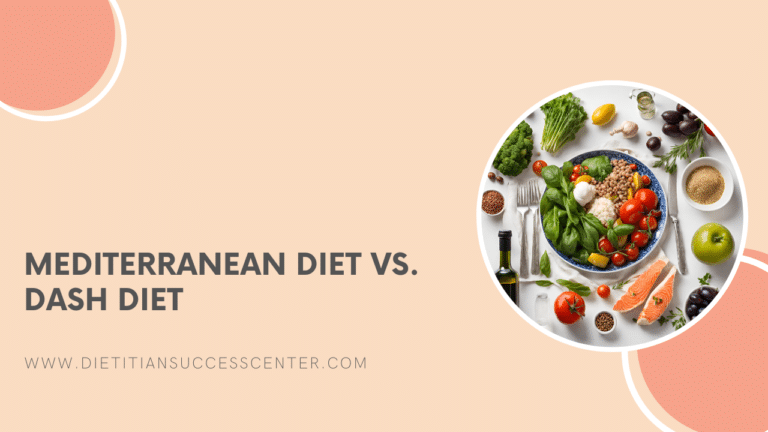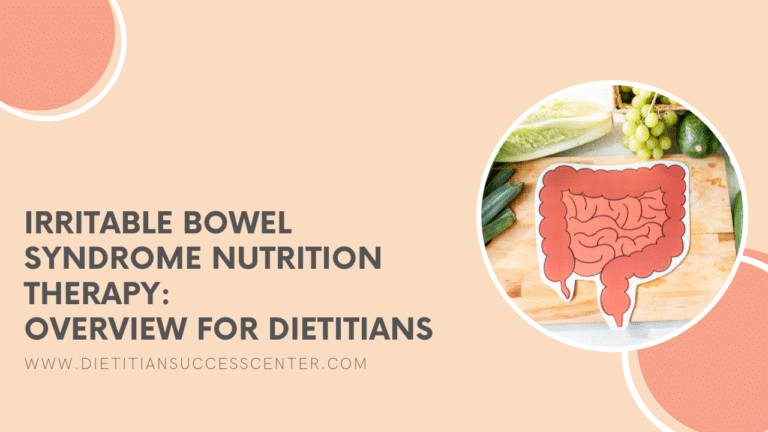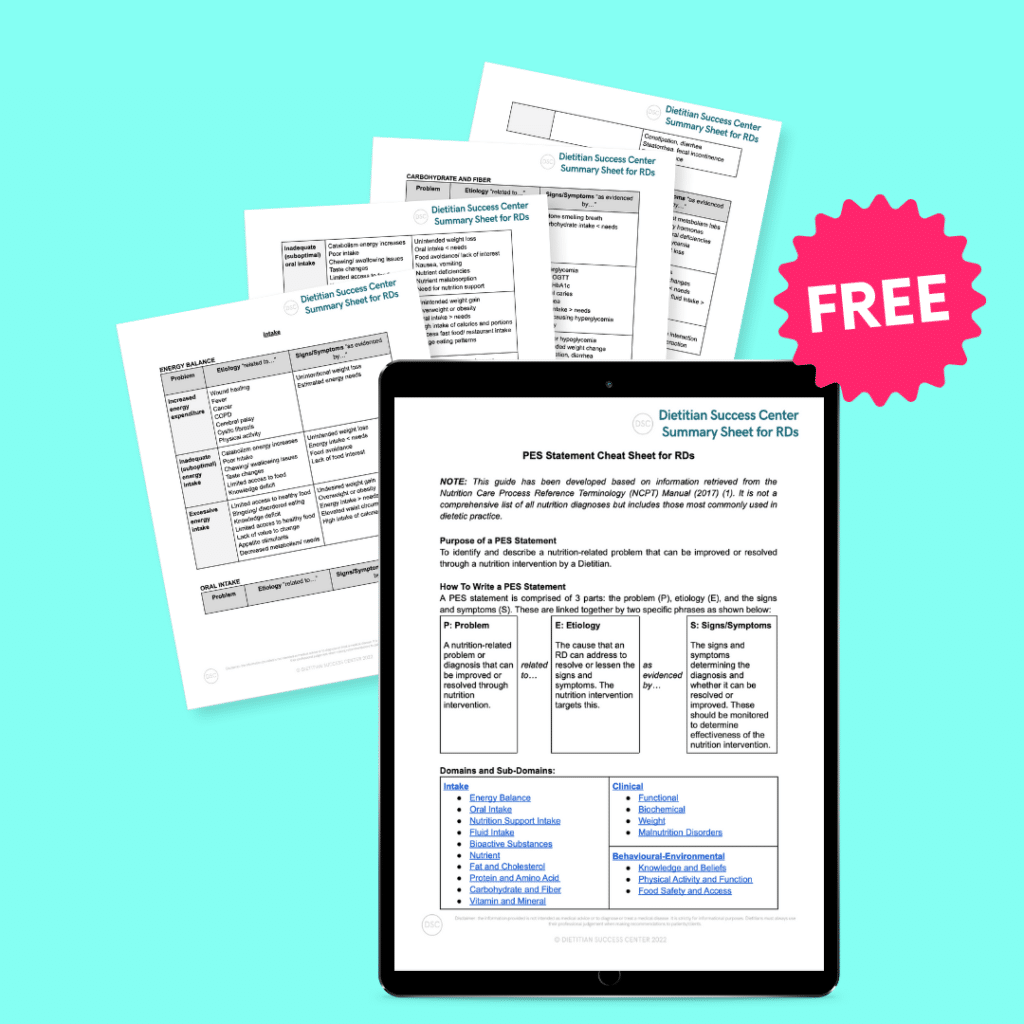

Written by Olivia Farrow, RD, MHSc
Reviewed by Krista Kolodziejzyk, RD, MPH, MBA
What is a PES statement?
A PES statement is a nutrition diagnosis that is part of the nutrition care process (not to be confused with a medical diagnosis). It is a structured sentence that is typically a part of your chart note to help communicate your nutrition diagnosis.
This blog post has been been developed based on information retrieved from the electronic Nutrition Terminology Reference Manual (eNCPT) 2023 edition (1).
Writing PES statements can feel a bit complicated, so we created our Nutrition PES Statement Cheat Sheet, a free resource with 17 pages of sample PES statements for dietetic practice!
Get your FREE Nutrition PES Statement Cheat Sheet.
Why do we need PES Statements?
PES statements are useful for communicating the nutrition-related problem that can be improved or resolved by nutrition intervention. They help to summarize your nutrition assessment and give justification for the next steps of the nutrition intervention.
How to Write a PES Statement
A PES statement has 3 parts (1):
P: Problem
- A nutrition-related problem or diagnosis that can be improved or resolved through nutrition intervention.
E: Etiology
- The cause that the dietitian can address to resolve or lessen the signs and symptoms. The nutrition intervention targets this.
S: Signs & Symptoms
- The signs and symptoms determining the diagnosis and whether it can be resolved or improved. These should be monitored to determine the effectiveness of the nutrition intervention.
These sections are combined in a structured sentence by the phrases “related to” and “as evidenced by”, as below:
The PROBLEM related to ETIOLOGY as evidenced by SIGNS and SYMPTOMS
Writing Your PES Statement
Start with the Problem
There are 3 domains that the “problem” in your statement might fall under:
- Intake – too much or too little energy, nutrients, fluid, etc. Note that intake is the more preferable domain because it is more likely the dietitian can address problems within this domain.
- Clinical – medical/physical conditions.
- Behavioral-Environmental – knowledge/attitudes/beliefs, physical environment (access to food, food safety), etc.
The DSC Nutrition PES Statement Cheat Sheet breaks down PES statement terminology into these three domains and 17 sub-domains that can be easily accessed with in-text links – to save you time!
Check your PES Statement problem by asking yourself the following questions:
- Can I, as the dietitian, improve this nutrition diagnosis?
- Is the most important problem addressed?
The Etiology
The etiology is the root cause of the problem that the dietitian can address or at least lessen the signs and symptoms of.
Check your PES Statement etiology by asking yourself the following questions:
- Is this the main root cause of the problem?
- Will I, as the dietitian, be addressing this root cause (or the associated signs and symptoms) in the intervention?
The Signs and Symptoms
The signs and symptoms are the supporting evidence that the nutrition problem exists. They help to provide quantitative and qualitative data, directly from your assessment, to support the problem. Monitoring these signs and symptoms will indicate the effectiveness of the nutrition intervention.
Check your PES Statement signs and symptoms by asking yourself the following questions:
- Will measuring the signs and symptoms help to evaluate progress?
- Are they specific enough that the dietitian can monitor the improvement of the nutrition diagnosis?
Check your entire PES statement by asking yourself the following questions:
- Is the PES statement based on the nutrition assessment data?
- Is the PES statement clear and concise?
- Is this PES statement factually correct and specific to this client?
Sample PES Statements
Use these PES statement examples, created using our Nutrition PES Statement Cheat Sheet, to get started writing an awesome PES Statement! Remember to design your own PES statement based on your unique client’s assessment and nutritional needs.
Sample PES Statement for Hypertension
Excessive sodium intake related to excessive consumption of high-sodium and heavily processed foods as evidenced by blood pressure value of 185/115, diagnosed hypertension, 24-hour recall showing high sodium and processed foods at each meal and snack with approximate sodium consumption of 4000 mg / day.
Sample PES Statement for Malnutrition
Moderate malnutrition related to limited access to food due to food insecurity as evidenced by unintended weight loss, self-reported loss of muscle and fat stores, diet history showing total energy, macronutrient, and micronutrient intake less than needs, and client report of inability to afford and obtain food.
Sample PES Statement for Diabetes
Inadequate fiber intake related to limited food and nutrition knowledge concerning importance of fiber-rich foods for diabetes as evidenced by limited formal diabetes education, diet history showing only low-fiber carbohydrate foods consumed, elevated postprandial glucose levels.

At DSC, we make it easier for dietitians and dietetic students to build expertise in various areas of practice including clinical nutrition topics. Our courses and toolkits, ready-to-use client handouts, and community can help you feel more confident supporting your clients in any area of dietetics!
Dietitian Success Center is THE professional development resource for dietitians and dietetic students. Our mission is to make it easier for dietitians and dietetic students to build expertise. We do this through evidence-based online nutrition courses, community and ready-to-use client handouts. Plus – we give you the tools to start and grow your dietitian private practice!
References:









